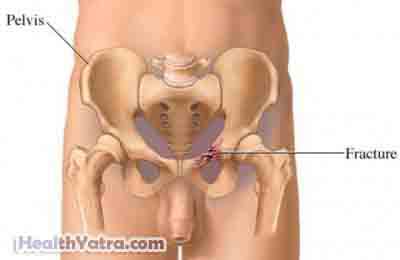Pelvic Fracture Treatment in India
A pelvic fracture is defined as one or more breaks (fractures) of the bones comprising the pelvis. This is a serious condition that requires immediate care from your doctor.

Causes
- In elderly people, pelvic fractures are usually caused by falls—often down stairs.
- The worst pelvic fractures, however, are caused by major impacts to the body, such as motorcycle or car accidents, or falls from high places.
Risk Factors
A risk factor is something that increases your chance of getting a disease or condition. The following factors increase your chance of developing pelvic fractures:
- History of falls
- Osteoporosis
- Decreased muscle strength
Symptoms
Symptoms of a pelvic fracture include:
- Pelvic pain
- Pain upon walking, or inability to walk
You may have other injuries such as other broken bones or damage to your liver, kidneys, or other internal organs—especially if your fracture is caused by a motor vehicle accident. These other injuries can increase your risk of death. They may cause blood loss inside your abdomen (internal bleeding) that may leave too little blood available for pumping to the heart, brain, and other important parts of the body (a condition called “shock”). The pelvic fracture itself causes significant blood loss.
Diagnosis
Your doctor will ask about your symptoms and medical history, and perform a physical examination. He or she will likely refer you to a doctor who specializes in multiple injuries (a trauma specialist) and/or bone injuries (an orthopedic surgeon). ). If you are in a car accident, you will probably be taken to a hospital emergency room which is prepared for such situations. Tests may include the following:
- Blood and urine tests—to watch for ongoing blood loss, and to see if the bladder is involved.
- X-rays —of your pelvis to find exactly where and how severe the fracture is.
- A pregnancy test may be done if you are a woman of childbearing age. The test is done to help doctors protect the baby if you are pregnant, and to find and stop any possible pregnancy-related causes of bleeding such as miscarriage.
- CT scan (CAT scan) —a procedure that makes detailed computer pictures of the inside of your abdomen to find the pelvic fracture and look for other injuries and internal bleeding. This is also called computed tomography or computerized axial tomography.
- MRI (magnetic resonance imaging) —a procedure that uses a magnet, radio waves, and a computer to make detailed pictures of the inside of your abdomen.
- Abdominal ultrasound —a procedure that uses sound waves to find internal bleeding and other injuries within your abdomen.
- Urethrography—a test in which dye is injected into your urethra (the passage into your bladder) to check for injuries to this area. A similar test in which dye is injected into your bladder is called cystography.
- Arteriography —a test in which dye is injected into one or more of your arteries to check for internal bleeding within your pelvis.
Treatment
You and/or your family should talk with your doctor about the best treatment plan for you. A pelvic fracture is a serious injury that may be complicated by injuries to other parts of your body. Treatment first focuses on stopping any internal or external bleeding caused by your accident, then on the diagnosis and treatment of both the pelvic fracture and any associated injuries.
Many people need surgery to repair their pelvic fractures or other injuries. Blood transfusions and antibiotics may be part of the early care. Early fracture stabilization, bedrest, and appropriate physical therapy and other rehabilitation care are very important to making a good recovery, which will usually take months.
If you are diagnosed with a pelvic fracture, follow your doctor’s instructions .
Prevention
To help reduce your chance of getting pelvic fractures, take the following steps:
- Prevent falls by using a stool or stepladder to reach high places. Add handrails along stairways and place nonslip mats in your bathroom, shower, and under carpets.
- Lower your chance of injuries due to car and motorcycle accidents by always wearing your seatbelt. Never drive if you have been drinking, and don’t ride with anyone else who has either.
- Always use safety precautions to avoid falls during high-risk sports, such as rock climbing and mountaineering.
- Maintain your muscle strength which will help to prevent falls.
